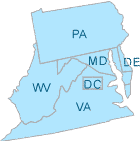Region 3: Risk Assessment Contacts
Region 3 (Mid-Atlantic) Contacts
Technical Support Branch
- Branch Chief, Laura A. Mohollen (mohollen.laura@epa.gov), 215-814-3295
Risk Assessment Section
- Section Chief, Cathleen Kennedy (kennedy.cathleen@epa.gov), 215-814-2746
Human Health Risk Assessment
- Martin Gehlhaus (gehlhaus.martin@epa.gov), 215-814-3359
Ecological Risk Assessment
- Matt Taynor (taynor.matthew@epa.gov), 215-814-3351
- Bruce Pluta (pluta.bruce@epa.gov), 215-814-2380
General Information
- National Response Center - 800-424-8802
- Superfund - 800-553-2509
- Contact Region 3 - 215-814-5000, or 800-438-2474
- About Region 3 (Mid-Atlantic)
Region 3 Risk Assessment Resources
- Assessing Dermal Exposure from Soil
- Biological Technical Assistance Group (BTAG) Screening Values (Benchmarks)
- Exposure Point Concentrations is Groundwater
- Guidance on Handling Chemical Concentration Data Near the Detection Limit in Risk Assessments
- Selecting Exposure Routes and Contaminants of Concern by Risk-Based Screening
- Updated Dermal Exposure Assessment Guidance
- Regional Fish Consumption Screening Levels
Region 3 Cleanup Resources
- Environmental Science Center (Laboratory and Field Services)
- Toxic Air Pollutants in the Mid-Atlantic States
- Recent Approvals of State Implementation Plan (SIP) Revisions and Other Pollutant Plans
- Infrastructure State Implementation Plan (SIP) Requirements and Guidance
- EPA's Requirements for the Control of Gasoline Dispensing Facility (GDF) Emissions
- Multi-Criteria Integrated Resource Assessment Tool (MIRA)
- Risk Based Screening Tables (RSLs)

